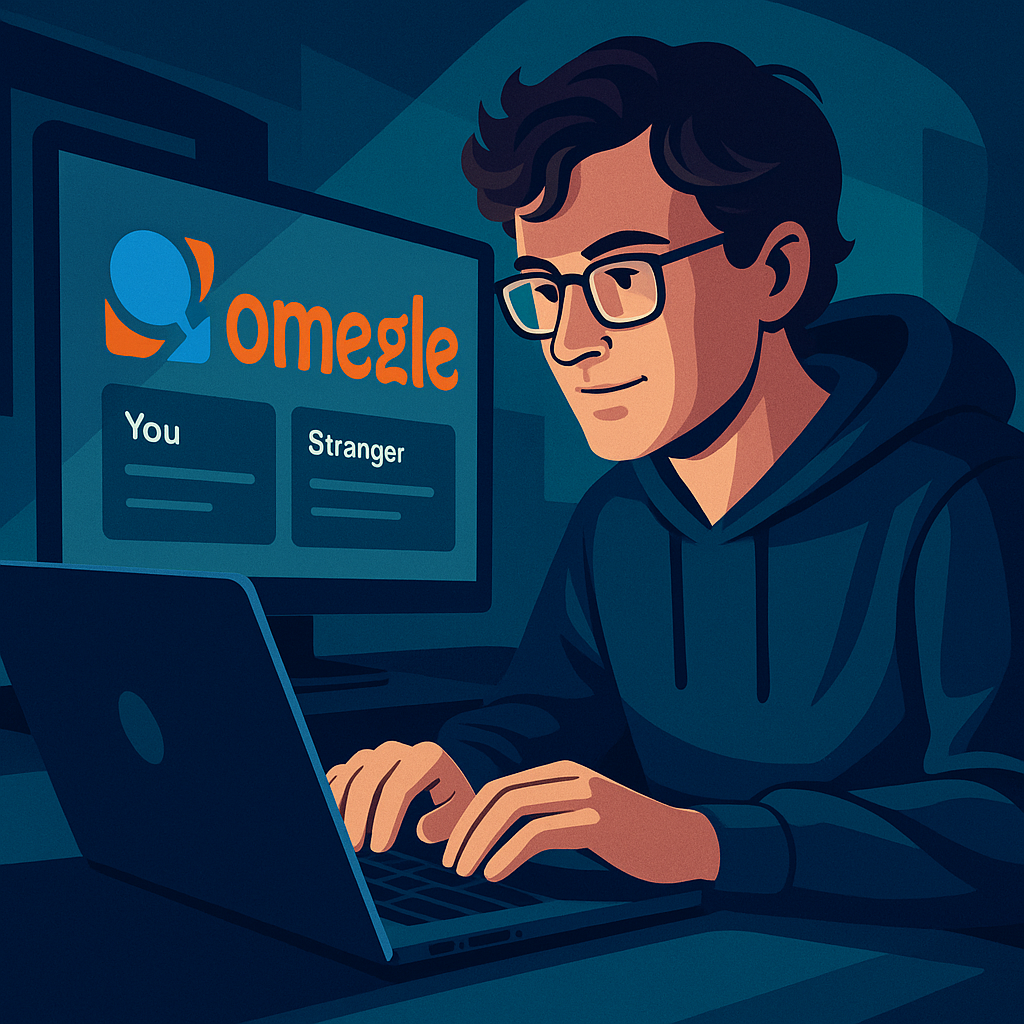Leif K‑Brooks: From Teen Coder to Omegle Founder– The Full Story
The Visionary Behind Omegle: Leif K-Brooks

“If the Internet is a global village, Omegle was my way of strolling down its streets and bumping into whoever I met.” — Leif K-Brooks
The idea that would rewrite random chat culture came from a shy 18-year-old in rural Vermont. In March 2009, Leif K-Brooks uploaded a skinny webpage with two text panes labeled You and Stranger. Within days it exploded, quickly topping 150 000 daily visits, according to the Omegle Wikipedia page. The site’s recipe was almost suspiciously simple: no log-ins, no profiles, pure digital serendipity.
From Maple Syrup Country to Millions of Strangers
Brooks grew up in Brattleboro, Vermont—a dot on the map better known for autumn foliage than tech meet-ups. Unable to find like-minded coders nearby, he spent middle-school evenings hanging out in IRC channels and teaching himself JavaScript, PHP, and Python. By the time driver’s-ed rolled around, he already dreamed of connecting “anyone to everyone.”
His first public experiment was Omegle, launched on March 25 2009. It took only a weekend to code, but it scratched a universal itch: curiosity. In an era when Facebook required a real name, Omegle’s anonymity felt rebellious and liberating.
The Weekend Project That Went Viral
Early press coverage—including the New York Times story “Tired of Old Web Friends? A New Site”—sent curious surfers flooding in. Less than four weeks after launch, Omegle was clocking the six-figure page-view counts documented by NDTV’s retrospective, “Omegle Shuts Down: 5 Points on Online Chat Website.”
Brooks stacked on features at light speed:
- Video chat (2010) turned webcams into a roulette wheel.
- Spy Mode allowed one user to ask a question and watch two strangers debate.
- Interest Tags tried to pair people by shared hobbies.
Each tweak arrived with minimal friction—no new settings pages, no complicated UI. “Ship fast, iterate faster” might as well have been carved on Omegle’s servers.
Why Omegle Clicked with Internet Culture
- Zero Barriers = Infinite Possibilities
No accounts, no history, no baggage. You could role-play a pirate at 8 p.m. and rehearse job-interview answers at 9. - Global Reach in a Single Click
Teens in Iowa suddenly chatted with retirees in Istanbul, cultivating micro-lessons in cross-cultural empathy. - The Birth of Reaction Content
YouTubers turned Omegle encounters into viral gold—guitar serenades, improv comedy, jump-scare pranks. Entire TikTok trends spun out of screen-recorded stranger moments. - Lockdown Loneliness Antidote
Traffic spiked again during 2020’s stay-at-home orders; Wired notes the site “regained popularity” when pandemic boredom peaked in its exposé on the shutdown, “Omegle Was Forced to Shut Down by a Lawsuit From a Sexual Abuse Survivor.”
When the Party Got Dark
Anonymity is a double-edged sword. By the mid-2010s, predators had discovered Omegle’s open door, prompting mounting parental warnings, negative press, and eventually lawsuits. Brooks bolted on keyword filters, AI nudity classifiers, and a 24/7 volunteer moderator squad. Still, Wired’s deep dive recounts how a single survivor’s 2021 lawsuit over child exploitation ultimately became the legal time-bomb that doomed the platform.
The toll wasn’t just financial. Brooks answered abuse-report emails at 3 a.m. from his laptop—still mostly a one-man dev-ops team. Stress piled high enough that he later confessed he’d wake up to heart-palpitations.
November 8 2023: Pulling the Plug
“Operating Omegle is no longer sustainable—financially or psychologically. Frankly, I don’t want to have a heart attack in my 30s.”
—Leif K-Brooks, shutdown letter, quoted by Hindustan Times’ “I don’t want to have a heart attack…”
Visitors that day found the usual chat box replaced by a stark white page and Brooks’s 800-word farewell. In it he thanked “everyone who used Omegle for positive purposes” and conceded that abuse-prevention costs now eclipsed any revenue a free site could muster.
Life After Random Chats: Octane AI & Beyond
Brooks never stopped building. In 2016 he co-founded Octane AI, a Shopify-focused bot company that helps brands automate Messenger and SMS conversations. Forbes’ profile of him on its 30-Under-30 list praises the pivot from consumer chat chaos to revenue-driven e-commerce tools—see “Leif K-Brooks – Forbes 30 Under 30.” TechCrunch likewise spotlighted the startup’s $1.5 million seed round in “General Catalyst-Backed Octane AI Will Make You a Bot.”
Today, Brooks splits time between Octane AI product meetings and mentoring younger founders who ask how to build responsibly at scale—hard-won wisdom after Omegle’s turbulence.
Five Takeaways for Future Chat Innovators
| Lesson | Why It Matters |
|---|---|
| Frictionless UX wins eyeballs | Omegle’s one-click start button beat every onboarding flow on Earth. |
| Anonymity demands over-engineering safety | If you remove identity speed-bumps, double your moderation budget. |
| Viral doesn’t equal viable | Daily users don’t pay server bills if the model is ad-averse. |
| Legal risk grows in silence | Ignoring early red flags? Lawyers will eventually ring louder. |
| Know when to exit | Shutting down saved Brooks’s health—and likely spared users further harm. |
Your Turn — Drop Your Wildest Omegle Story 🎤
Omegle may be gone, but its spirit of digital spontaneity lives on. Scroll down and share the funniest, weirdest, or most heart-warming stranger encounter you ever had. Who knows—your comment might inspire the next Leif K-Brooks to invent a safer, smarter way to connect the globe.

